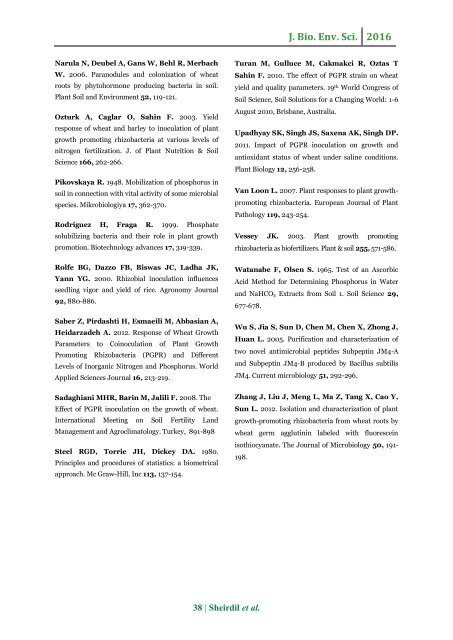Characterization and identification of wheat (Triticum aestivum L.) rhizospheric bacteria by using 16s rRNA gene sequencing
Bacterial strains were isolated from wheat rhizospheric soil with the aim to explore potential strains for the biofertilizer technology suitable to the local climate and conditions. All the isolates were characterized for their plant growth promoting (PGP) activities such as IAA production, P-solublization, nifH gene presence, catalase and oxidase production. The promising and potential strains based on their PGP activities were tested in two experiments of wheat. In the first growth chamber experiment, ten strains were inoculated with the seeds and sown in small pots filled with the soil. All the strains showed positive results in yield attributes of the plant like shoot length, root length, fresh and dry weight. Further, six strains which performed best in the growth chamber experiment were tested in a pot experiment under controlled conditions and the results showed that each strain significantly increased like shoot length (7.6-25%), root length (19.7-34.1%), number of tillers (33.3-100%), fresh weight (17.8-31.3%), dry weight (19.3-48.6%), spike length (4.3-28.2%) and grain yield (7.6-41.5%) of wheat plants over control. The strains used in the pot experiment were identified by standard procedure of 16s rRNA gene sequencing which showed that two of strains were from genus Bacillus, two from Pseudomonas, one from Acinetobacter and one from Jeotgalicoccus.
Bacterial strains were isolated from wheat rhizospheric soil with the aim to explore potential strains for the biofertilizer technology suitable to the local climate and conditions. All the isolates were characterized for their plant growth promoting (PGP) activities such as IAA production, P-solublization, nifH gene presence, catalase
and oxidase production. The promising and potential strains based on their PGP activities were tested in two experiments of wheat. In the first growth chamber experiment, ten strains were inoculated with the seeds and sown in small pots filled with the soil. All the strains showed positive results in yield attributes of the plant like
shoot length, root length, fresh and dry weight. Further, six strains which performed best in the growth chamber experiment were tested in a pot experiment under controlled conditions and the results showed that each strain significantly increased like shoot length (7.6-25%), root length (19.7-34.1%), number of tillers (33.3-100%), fresh
weight (17.8-31.3%), dry weight (19.3-48.6%), spike length (4.3-28.2%) and grain yield (7.6-41.5%) of wheat plants over control. The strains used in the pot experiment were identified by standard procedure of 16s rRNA gene sequencing which showed that two of strains were from genus Bacillus, two from Pseudomonas, one from Acinetobacter and one from Jeotgalicoccus.
Create successful ePaper yourself
Turn your PDF publications into a flip-book with our unique Google optimized e-Paper software.
J. Bio. Env. Sci. 2016<br />
Narula N, Deubel A, Gans W, Behl R, Merbach<br />
W. 2006. Paranodules <strong>and</strong> colonization <strong>of</strong> <strong>wheat</strong><br />
roots <strong>by</strong> phytohormone producing <strong>bacteria</strong> in soil.<br />
Plant Soil <strong>and</strong> Environment 52, 119-121.<br />
Ozturk A, Caglar O, Sahin F. 2003. Yield<br />
response <strong>of</strong> <strong>wheat</strong> <strong>and</strong> barley to inoculation <strong>of</strong> plant<br />
growth promoting rhizo<strong>bacteria</strong> at various levels <strong>of</strong><br />
nitrogen fertilization. J. <strong>of</strong> Plant Nutrition & Soil<br />
Science 166, 262-266.<br />
Pikovskaya R. 1948. Mobilization <strong>of</strong> phosphorus in<br />
soil in connection with vital activity <strong>of</strong> some microbial<br />
species. Mikrobiologiya 17, 362-370.<br />
Rodríguez H, Fraga R. 1999. Phosphate<br />
solubilizing <strong>bacteria</strong> <strong>and</strong> their role in plant growth<br />
promotion. Biotechnology advances 17, 319-339.<br />
Rolfe BG, Dazzo FB, Biswas JC, Ladha JK,<br />
Yann YG. 2000. Rhizobial inoculation influences<br />
seedling vigor <strong>and</strong> yield <strong>of</strong> rice. Agronomy Journal<br />
92, 880-886.<br />
Saber Z, Pirdashti H, Esmaeili M, Abbasian A,<br />
Heidarzadeh A. 2012. Response <strong>of</strong> Wheat Growth<br />
Parameters to Coinoculation <strong>of</strong> Plant Growth<br />
Promoting Rhizo<strong>bacteria</strong> (PGPR) <strong>and</strong> Different<br />
Levels <strong>of</strong> Inorganic Nitrogen <strong>and</strong> Phosphorus. World<br />
Applied Sciences Journal 16, 213-219.<br />
Sadaghiani MHR, Barin M, Jalili F. 2008. The<br />
Effect <strong>of</strong> PGPR inoculation on the growth <strong>of</strong> <strong>wheat</strong>.<br />
International Meeting on Soil Fertility L<strong>and</strong><br />
Management <strong>and</strong> Agroclimatology. Turkey, 891-898<br />
Steel RGD, Torrie JH, Dickey DA. 1980.<br />
Principles <strong>and</strong> procedures <strong>of</strong> statistics: a biometrical<br />
approach. Mc Graw-Hill, Inc 113, 137-154.<br />
Turan M, Gulluce M, Cakmakci R, Oztas T<br />
Sahin F. 2010. The effect <strong>of</strong> PGPR strain on <strong>wheat</strong><br />
yield <strong>and</strong> quality parameters. 19 th World Congress <strong>of</strong><br />
Soil Science, Soil Solutions for a Changing World: 1-6<br />
August 2010, Brisbane, Australia.<br />
Upadhyay SK, Singh JS, Saxena AK, Singh DP.<br />
2011. Impact <strong>of</strong> PGPR inoculation on growth <strong>and</strong><br />
antioxidant status <strong>of</strong> <strong>wheat</strong> under saline conditions.<br />
Plant Biology 12, 256-258.<br />
Van Loon L. 2007. Plant responses to plant growthpromoting<br />
rhizo<strong>bacteria</strong>. European Journal <strong>of</strong> Plant<br />
Pathology 119, 243-254.<br />
Vessey JK. 2003. Plant growth promoting<br />
rhizo<strong>bacteria</strong> as bi<strong>of</strong>ertilizers. Plant & soil 255, 571-586.<br />
Watanabe F, Olsen S. 1965. Test <strong>of</strong> an Ascorbic<br />
Acid Method for Determining Phosphorus in Water<br />
<strong>and</strong> NaHCO3 Extracts from Soil 1. Soil Science 29,<br />
677-678.<br />
Wu S, Jia S, Sun D, Chen M, Chen X, Zhong J,<br />
Huan L. 2005. Purification <strong>and</strong> characterization <strong>of</strong><br />
two novel antimicrobial peptides Subpeptin JM4-A<br />
<strong>and</strong> Subpeptin JM4-B produced <strong>by</strong> Bacillus subtilis<br />
JM4. Current microbiology 51, 292-296.<br />
Zhang J, Liu J, Meng L, Ma Z, Tang X, Cao Y,<br />
Sun L. 2012. Isolation <strong>and</strong> characterization <strong>of</strong> plant<br />
growth-promoting rhizo<strong>bacteria</strong> from <strong>wheat</strong> roots <strong>by</strong><br />
<strong>wheat</strong> germ agglutinin labeled with fluorescein<br />
isothiocyanate. The Journal <strong>of</strong> Microbiology 50, 191-<br />
198.<br />
38 | Sheirdil et al.

















